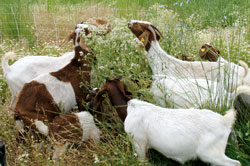When Nebraska producer Teri Edeal purchased a quarter section of irrigated bottom ground and applied for SARE funds to experiment with cool-season irrigated grass mixes, her neighbors were her biggest skeptics. After all, they reasoned, that piece of ground measured about 8.5 to 9 on the pH scale, way too saline for plants to grow. Edeal – who works with her husband, Brian, to feed 3,500 yearlings up to finished weight for other owners each year – persevered, planting saline-tolerant varieties that could be grazed and eventually reduce the soil salinity.

“Since 1998, we’ve grazed that pasture every year, and the neighbors have quit whispering to my husband,” Edeal says. “And that pasture has been a life-saver during this drought.”
Edeal planted a complex mix that included tall wheatgrass, Garrison creeping foxtail, intermediate wheatgrass, Russian wildrye, orchardgrass, birdsfoot trefoil and Alsike clover. The species will thrive in saline soil, and even transfer the minerals that are toxic to other plants from the soil to their stems and leaves. When these plants are grazed or harvested for hay, the salinity leaves with the plant.
Edeal may have reduced salinity, but she is still working to develop the best combination of species. The tall wheatgrass – the least palatable species for most of the grazing season – has taken over, and most of the legumes have essentially disappeared. Typically, legumes can be grazed short, but not often. Meanwhile, tall grasses such as those Edeal planted can be grazed often, but not short. In Edeal’s rapid 16-paddock rotation, the legumes could not withstand the grazing pressure.
Edeal planted her forage mix in the fall so she could graze it the next June. Moreover, she wanted the grass established before weeds gained a huge competitive advantage. In 2002, a renter grazed 160 cow-calf pairs on the property. Those calves gained 2.8 pounds per day, bringing the renter’s net income to more than $34,000. As landlords, the Edeals netted – after fertilizer, irrigation and mortgage payments – $2,366.
“The next year, we added some of our own cattle so we could increase our income substantially,” Edeal says.
If she had to do it over again, Edeal would start with eight paddocks under her 130-acre pivot instead of 16. Also, she would limit her seed mix to two or three varieties of grass – including, of course, a warm-season variety to carry her grazing capacity through the hot summer months.
